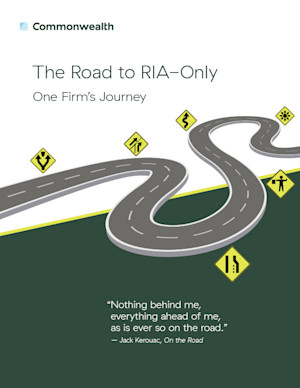For years, the industry has been moving toward the fee-only model, and by now many advisors may think they understand what it means to run a fee-only business. From the
transparent fee structure to the compliance and marketing flexibility, the advantages seem quite clear.
But there are some unexpected nuances of being a fee-only advisor that can come as a surprise, too. And once you start exploring the move to fee-only, you may find that the
realities of the experience aren’t quite in line with your perceptions.
Let’s explore some of the common assumptions about running a fee-only business to give you a clear idea of what to expect if you decide the fee-only path is right for you. Whether you’re considering an IAR-only approach or running your own independent RIA, there can be benefits and potential hiccups—and being aware of both will help make for a much smoother transition.
Going Fee-Only Means You Have to Be Fee-Only
Sometimes, advisors think of themselves as fee-only when they’re actually fee-mostly. Although they’re primarily focused on fee-based business, they maintain some commission-based business as well, however negligible it may be.
But when you become a fee-only advisor, it means exactly that—you have to be fee-only.
Regardless of whether you choose an IAR-only or RIA-only affiliation model, going fee-only means you need to drop your FINRA securities registrations, after which you lose the ability to sell FINRA commission products, and all legacy FINRA trail revenue will cease. If you’ve been concentrating on the fee-based part of your practice for a while, this may come as news to you.
Dropping your FINRA registrations has practical implications as well as emotional ones. For some advisors, the idea that they can’t sell certain products they think may be the right fit for clients doesn’t sit well. They may want to hold on to FINRA securities registrations to keep the door open in case they want to sell commissionable products in the future. Similarly, others may wish to retain their FINRA registrations to continue receiving trail commissions. But for
those advisors who have made the change—and are acting in a true fiduciary capacity and seeing different growth opportunities—they often do not look back.
No One-Size-Fits-All Approach
Even if fee-only is what you envision for your business, be aware that no single approach works for everyone. The reality of if and when you make the move will depend on your specific circumstances. There are several factors to consider to help you determine if it’s
time to make the move so you’re positioned to take advantage of everything a fee-only approach has to offer. Keep in mind the benchmarks—in general, offices that are best suited for a fee-only affiliation have:
Some advisors, whose circumstances require them to give up fee-based revenue or who are
revenue neutral, find the move to fee-only provides an opportunity to streamline their books of business. For some legacy commission accounts, it may make sense to convert those assets to a fee-based account or a fee-only variable annuity. Remember, though, any
conversion must be in the best interest of the client. In other cases where clients are less ideal, it may be the right time to part ways. This is a chance to refine or prune your book to ensure that your relationships are aligned with your growth goals and business direction.
More to Marketing Than Meets the Eye
As a fee-only advisor, you’re excited by the prospect of greater freedom and possibilities for marketing yourself. While you might be anxious to get started, you may be surprised to find that there are some subtleties to marketing yourself as fee-only that could throw an unexpected wrench into your plans.
To market yourself as fee-only, your revenues must come entirely from advisory business—none of your compensation can come from the sale of commission products or from trail revenue. This is where things can get confusing. If you’re a fee-only advisor and have an insurance license, you can still earn commissions on insurance and fixed annuity sales as well as receive trail commissions on insurance products sold previously. But by doing this, you lose the ability to market yourself as fee-only. Even though you’re allowed to earn the insurance commission, from a marketing standpoint, it’s considered commission despite not being from the sale of FINRA products.
Things get even more complicated if you hold the CFP® certification. A CFP® professional may represent their firm’s compensation method as fee-only, but only if the CFP®
professional and their firm receive no sales-related compensation. This means if you’re a CFP® practitioner affiliated as an IAR of your partner firm’s corporate RIA, you can’t market yourself as fee-only if your partner receives sales-related compensation.
This is not to say that you can’t adapt your marketing strategy as a fee-only advisor even if
you can’t use the term “fee-only” based on the circumstances above. Some advisors highlight their role as a fiduciary, emphasizing that they put their clients’ best interests above their own. This message can be even more powerful than just stating that you are fee-only.
Compliance Flexibility Comes with Complexities
Perhaps one of the most eye-opening realities of going fee-only is the compliance responsibility. RIA-only advisors operate their businesses through their own RIA entity. While this opens up the potential for greater compliance flexibility, with that comes with significant regulatory, risk, and compliance responsibilities that require a notable investment of time and manpower.
As an RIA-only advisor, you’re responsible for creating, managing, and testing—as well as covering the cost of—your own compliance program to ensure that your organization meets
its regulatory requirements. Plus, RIAs must designate a chief compliance officer (CCO) to take responsibility for the firm’s compliance program. The enormity of managing your own compliance can seem like a full-time job in itself, but you may find that the benefits of an RIA-only affiliation outweigh the extra efforts.
Know Before You Make the Move
Going fee-only isn’t for everyone, but if you are considering it, be sure to do your due diligence first. Having a clear idea of what’s involved from the get-go can make a difference—in both ensuring a smooth transition and enabling you to optimize the benefits after making the move.

FREE DOWNLOAD
The Road to RIA-Only:
One Firm’s Journey
Gain an insider’s view into the opportunities, challenges, and realities of going fee-only an running an RIA business from two advisors who made the leap.


